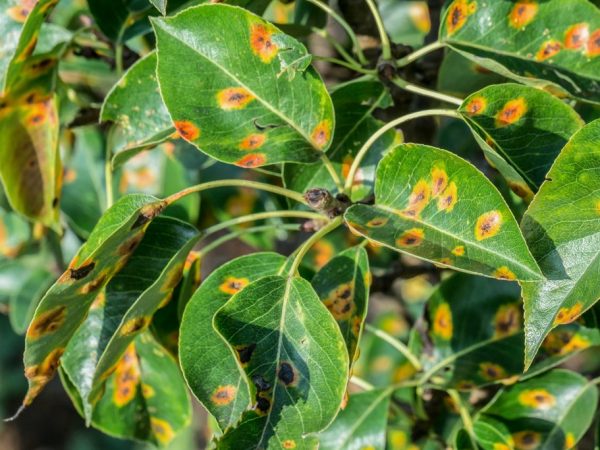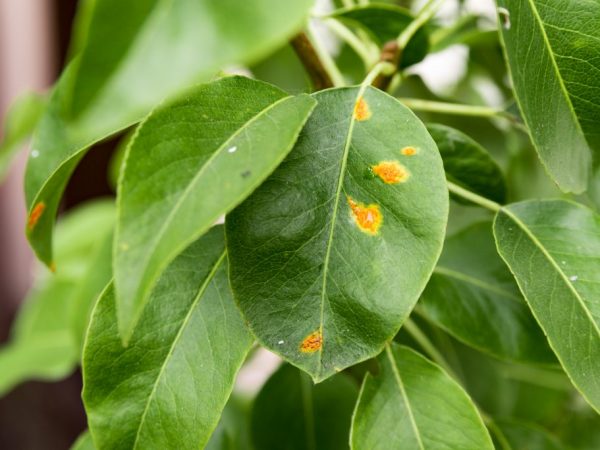Causes of stains on the pear
Spots on the leaves of a pear indicate a disease of the tree. By their color, they determine what it suffers from.

Causes of stains on the pear
Rusty or black spots are most common. Then it is safe to say that the plant was struck by rust or scab. These are dangerous diseases that threaten a large loss of crops.
Diseases and causes
The first signs of rust are noticeable after flowering - orange spots on pear leaves with a yellow tint around the edges. Over time, they become red and large. Then they turn brown and reach a size of 1-1.5 cm. Black dots can be seen on their surface. In autumn, yellow growths form on the underside of the leaves, which contain many black spores. Damaged leaves die off faster, depriving the tree of food. Less commonly, the disease affects shoots and fruits.
A juniper growing nearby can provoke infection with a fungus. After all, at first, the spores grow on this plant, it is necessary for the wintering of the pathogen. In windy, warm and humid weather, the fungus travels long distances and gets on pears. It continues to develop there.
Usually rusty trees suffer from scab. Because their condition worsens - immunity decreases. The pear becomes vulnerable. Poorly tolerates winters. Cracks appear on the bark. Hollows are formed, which in the future can lead to the death of the culture.
With such a disease as scab, brown spots first appear, not clearly rounded, vague. After a few days, they turn black with a velvety coating. This disease affects not only the leaves, but also the fruits. Over time, the leaves dry out and fall off.
The cause of scab is a pathogenic fungus. It hibernates on young pear shoots. The disease spreads during flowering. Especially after heavy rainfall. Cold, rainy springs and summer create the most favorable conditions for the pathogen to rage. A pear can be struck by scab in dry weather, but with abundant dew.
Prophylaxis
In order to prevent the development of diseases, it is worth preventing them. After all, preventive measures do not require much effort.
To prevent rust, you need to:
- Always watch out for juniper bushes in your area and in the vicinity. If a fungus is found on them, it is worth removing the affected branches and burning them. An ideal option would be when neighbors nearby will also take preventive measures.
- Correctly carry out the agrotechnical process. It is necessary to form a crown, apply fertilizers, and harvest on time.
- In early November or in spring, before the buds have yet blossomed, trees are treated with a 5-7% carbamide solution. For 10 liters of water, 500-700 g of the product are given.
There are no varieties that are 100% rustproof. But there are some who are more resistant to the disease. Namely: Sugar, Sailo, Nanaziri. In industrial cultivation, pears do not suffer from rust, since there is no juniper nearby.
Preventive actions for scab:
- Cutting the crown annually - this will provide good lighting and quick blowing of the tree after rain.
- In the fall, under the tree, you must carefully collect all the leaves that were infected with the disease. They are buried in the ground, then they dig it up. Instead of digging, spraying can be used, which will destroy the infection. To do this, the foliage and the trunk circle are treated with a 7% urea solution. A bucket of water is given 700 g of the product.
- Remove affected leaves and shoots.
- It is necessary to maintain the distance between the fruit trees in the garden. Then the likelihood of the spread of the disease decreases.
- During the budding period, you can spray the tree with Agat-25K. To prepare the solution, give 3 g of the product to a bucket of water. Since the buds open in a short time, this process must be monitored. After all, you can miss the right moment.
- There are varieties that are resistant to black spot, namely Bere Bosk, Bere Diehl, Williams, Kieffer, Lyubimitsa Klappa. Therefore, you can plant them if you do not want to fight the scab.
Processing time

The frequency of treatment depends on the extent of the lesion.
Pears are sprayed in several stages. This is especially true if the disease strongly affected the tree.
When yellow spots appear on the leaves of a pear, the first treatment is carried out when the buds are swollen. During this period, they begin to blossom. The following should be applied after flowering. The third time is sprayed when the ovaries have reached the size of a hazelnut. And the last stage is when the ovaries are already in size, like a walnut.
In case of severe scab damage, the treatment can be carried out up to 5 times. It is worth starting during the formation and swelling of the kidneys. Further during the formation of buds. The next time it is sprayed after flowering. It is repeated two weeks later. The fifth treatment is carried out only for winter pear varieties in late summer - early autumn.
Folk methods of struggle
Red spots on pear leaves can be fought with folk remedies. They will be effective if the disease is at an early stage of development.
A popular remedy is wood ash infusion. It can be prepared in this way: 500 g of ash is given for 10 liters of water, insisted for 2 days.
An infusion of slurry can act as a therapeutic drug. It is prepared in two stages. The first time the substance is poured with water in a ratio of 1: 2, insisted for 2 weeks. Then it is again diluted with water in the same proportion.
The prepared products are used for watering trees. Consumption for an adult pear is 10 liters, for a young one - from 4 to 6 liters.
If black spots appear on the leaves of a pear, you can spray it with a solution of sodium chloride. To prepare the product, take it in an amount of 1 kg and dilute it in 10 liters of water. The dosage for an adult tree is 10 liters, for a young tree - 2 liters.
Chemicals
It is necessary to alternate the means for processing among themselves. This will give a good result in the fight against diseases. The use of one drug makes the tree addictive to it.
Anti-rust products
First of all, it is necessary to remove heavily affected shoots. In early spring, while the buds have not yet blossomed, it is worth cutting them off. With this procedure, 5-10 cm of an intact branch is captured. Weakly affected areas need to be treated. They are cleaned to healthy wood, disinfected with a 5% solution of copper sulfate. Can be treated with heteroauxin (0.5 g per 10 L of water). It promotes rapid healing. Further, the areas that are being treated are covered with garden varnish.
Copper sulfate, copper oxychloride are considered effective drugs in the fight against yellow spots, https://good-tips.pro/index.php/house-and-garden/orchard-and-garden/bordeaux-mixture-cooking-and-application ... When they appear, Bayleton is also used (10 g per 10 l of water). In spring and autumn after harvest, the following fungicides are used:
- Speed - 2 ml per 10 liters of water;
- Delan - 7 g per 10 liters of water;
- Tersel - 25 g per 10 liters of water.
Scab control products
To overcome the disease, it is necessary to spray the tree with copper sulfate with the addition of lime. It is worth alternating treatment with Bordeaux liquid. Calloidal sulfur or copper oxychloride will also be helpful instead.
During the period of swelling of the buds and the formation of buds, the fungicide Skor is suitable. In case of severe damage in the fall, after harvesting, they are treated with a 10% solution of ammonium nitrate. The trunk circle is also sprayed so that the substance does not fall on the bark.
When the black spot has struck the fruits, you need to get rid of them. Damaged shoots are removed, especially young ones.
Conclusion
When red or black spots appear on the pear, urgent action is needed. After all, you can lose most of the harvest, sometimes all.
If diseases are raging at the same time, it is worth using drugs that will perfectly cope with both of them. Then both the fruit and the tree can be saved.


